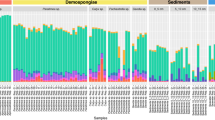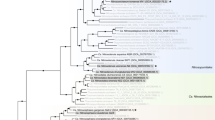Abstract
Aerobic ammonia-oxidizing bacteria (AAOB) are known to have an important function in the marine nitrogen cycle. Anaerobic ammonium oxidation (anammox) carried out by some members of Planctomycetales is also an important process in marine ecosystems. Ammonia-monooxygenase gene (amoA) fragments were amplified to investigate the potential for nitrification and the diversity of the AAOB in two marine sponges Ircinia strobilina and Mycale laxissima. All of the AmoA sequences obtained from the two sponges clustered with the AmoA sequences of the Betaproteobacteria Nitrosospira spp. To investigate the anaerobic ammonia-oxidizing bacteria (AnAOB) in sponges, 16S rRNA gene fragments of Planctomycetales and anammox bacteria were also amplified with specific primers, and clone libraries were constructed. The Planctomycetales diversity detected in the two sponges was different. The Planctomycetales community in M. laxissima was affiliated with Pirellula, Planctomyces and anammox bacteria, while all of the I. strobilina Planctomycetales clones were solely affiliated with the candidate phylum ‘Poribacteria’. Interestingly, sequences related to anammox genera were recovered only from M. laxissima. This is the first report of anammox bacteria in marine sponges. It is intriguing to find AAOB and AnAOB in M. laxissima, but the nature of their interaction with the sponge host and with each other remains unclear. This work further supports the potential of sponge-associated microorganisms for nitrification and sheds light on anammox as a new aspect of the nitrogen cycle in marine sponges.
Similar content being viewed by others
Log in or create a free account to read this content
Gain free access to this article, as well as selected content from this journal and more on nature.com
or
Accession codes
References
Bayer K, Schmitt S, Hentschel U . (2008). Physiology, phylogeny and in situ evidence for bacterial and archaeal nitrifiers in the marine sponge Aplysina aerophoba. Environ Microbiol 10: 2942–2955.
Brusca RC, Brusca GJ . (1990). Phylum Porifera: the sponges. In: Sinauer AD (ed). The Invertebrates. Sinauer Press: Sunderland, MA, USA, pp 181–210.
Bultel-Poncé V, Berge JP, Debitus C, Nicolas JL, Guyot M . (1999). Metabolites from the sponge-associated bacterium Pseudomonas species. Mar Biotechnol 1: 384–390.
Chouari R, Le Paslier D, Daegelen P, Ginestet P, Weissenbach J, Sghir A . (2003). Molecular evidence for novel planctomycete diversity in a municipal wastewater treatment plant. Appl Environ Microbiol 69: 7354–7363.
Codispoti LA, Brandes JA, Christensen JP, Devol AH, Naqvi SWA, Paerl HW, Yoshinari T . (2001). The oceanic fixed nitrogen and nitrous oxide budgets: moving targets as we enter the anthropocene? Sci Mar 65: 85–105.
Corredor JE, Wilkinson CR, Vicente VP, Morell JM, Otero E . (1988). Nitrate release by Caribbean reef sponges. Limnol Oceanogr 33: 114–120.
Diaz MC, Ward BB . (1997). Sponge-mediated nitrificaton in tropical benthic communities. Mar Ecol Prog Ser 156: 97–109.
Diaz MC, Akob D, Cary SC . (2004). Denaturing gradient gel electrophoresis of nitrifying microbes associated with tropical sponges. Boll Mus 1st Biol Univ Genova 68: 279–289.
Egli K, Bosshard F, Werlen C, Lais P, Siegrist H, Zehnder AJ, van der Meer JR . (2003). Microbial composition and structure of a rotating biological contactor biofilm treating ammonium-rich wastewater without organic carbon. Microb Ecol 45: 419–432.
Felsenstein J . (2004). PHYLIP (Phylogenetic Inference Package), Version 3.6. In Department of Genetics, University of Washington: Seattle, WA.
Fieseler L, Horn M, Wagner M, Hentschel U . (2004). Discovery of the novel candidate phylum ‘Poribacteria’ in marine sponges. Appl Environ Microbiol 70: 3724–3732.
Hallam SJ, Konstantinidis KT, Putnam N, Schleper C, Watanabe Y, Sugahara J et al. (2006a). Genomic analysis of the uncultivated marine crenarchaeote Cenarchaeum symbiosum. Proc Natl Acad Sci USA 103: 18296–18301.
Hallam SJ, Mincer TJ, Schleper C, Preston CM, Roberts K, Richardson PM, DeLong EF . (2006b). Pathways of carbon assimilation and ammonia oxidation suggested by environmental genomic analyses of marine Crenarchaeota. PLoS Biol 4: e95.
Hentschel U, Usher KM, Taylor MW . (2006). Marine sponges as microbial fermenters. FEMS Microbiol Ecol 55: 167–177.
Hentschel U, Hopke J, Horn M, Friedrich AB, Wagner M, Hacker J, Moore BS . (2002). Molecular evidence for a uniform microbial community in sponges from different oceans. Appl Environ Microbiol 68: 4431–4440.
Hoffmann F, Larsen O, Thiel V, Rapp HT, Reitner J . (2005). An anaerobic world in sponges. Geomicrobiol J 22: 1–10.
Jiménez E, Ribes M . (2007). Sponges as a source of dissolved inorganic nitrogen: nitrification mediated by temperate sponges. Limnol Oceanogr 52: 948–958.
Kartal B, van Niftrik L, Rattray J, van de Vossenberg JL, Schmid MC, Damsté JS et al. (2008). Candidatus ‘Brocadia fulgida’: an autofluorescent anaerobic ammonium oxidizing bacterium. FEMS Microbiol Ecol 63: 46–55.
Kartal B, Rattray J, van Niftrik LA, van de Vossenberg JL, Schmid MC, Webb RI et al. (2007). Candidatus ‘Anammoxoglobus propionicus’ a new propionate oxidizing species of anaerobic ammonium oxidizing bacteria. Syst Appl Microbiol 30: 39–49.
Kuenen JG, Jetten MSM . (2001). Extraordinary anaerobic ammonium-oxidizing bacteria. ASM News 67: 456–463.
Kuypers MM, Lavik G, Woebken D, Schmid M, Fuchs BM, Amann R et al. (2005). Massive nitrogen loss from the Benguela upwelling system through anaerobic ammonium oxidation. Proc Natl Acad Sci USA 102: 6478–6483.
Kuypers MM, Sliekers AO, Lavik G, Schmid M, Jørgensen BB, Kuenen JG et al. (2003). Anaerobic ammonium oxidation by anammox bacteria in the Black Sea. Nature 422: 608–611.
Li CW, Chen JY, Hua TE . (1998). Precambrian sponges with cellular structures. Science 279: 879–882.
Ludwig W, Strunk O, Westram R, Richter L, Meier H, Yadhukumar et al. (2004). ARB: a software environment for sequence data. Nucleic Acids Res 32: 1363–1371.
Maidak BL, Cole JR, Parker Jr CT, Garrity GM, Larsen N, Li B et al. (1999). A new version of the RDP (Ribosomal Database Project). Nucleic Acids Res 27: 171–173.
Mohamed NM, Colman AS, Tal Y, Hill RT . (2008a). Diversity and expression of nitrogen fixation genes in bacterial symbionts of marine sponges. Environ Microbiol 10: 2910–2921.
Mohamed NM, Enticknap JJ, Lohr JE, McIntosh SM, Hill RT . (2008b). Changes in bacterial communities of the marine sponge Mycale laxissima on transfer into aquaculture. Appl Environ Microbiol 74: 1209–1222.
Mohamed NM, Rao V, Hamann MT, Kelly M, Hill RT . (2008c). Monitoring bacterial diversity of the marine sponge Ircinia strobilina on transfer into aquaculture. Appl Environ Microbiol 74: 4133–4143.
Montalvo NF, Mohamed NM, Enticknap JJ, Hill RT . (2005). Novel actinobacteria from marine sponges. Antonie Leeuwenhoek 87: 29–36.
Müller WE, Blumbach B, Müller IM . (1999). Evolution of the innate and adaptive immune systems: relationships between potential immune molecules in the lowest metazoan phylum (Porifera) and those in vertebrates. Transplantation 68: 1215–1227.
Penton CR, Devol AH, Tiedje JM . (2006). Molecular evidence for the broad distribution of anaerobic ammonium-oxidizing bacteria in freshwater and marine sediments. Appl Environ Microbiol 72: 6829–6832.
Pile AJ . (1997). Finding Reiswig's missing carbon: quantification of sponge feeding using dual-beam flow cytometry. In: Lessios HA, Macintyre IG (eds). Proceedings of the 8th International Coral Reef Symposium. Smithsonian Tropical Research Institute: Balboa, Panama, pp 1403–1410.
Reiswig H . (1974). Water transport, respiration and energetics of three tropical marine sponges. J Exp Mar Biol Ecol 14: 231–249.
Reiswig HM . (1971). Particle feeding in natural populations of three marine demosponges. Biol Bull 141: 568–591.
Rotthauwe JH, Witzel KP, Liesack W . (1997). The ammonia monooxygenase structural gene amoA as a functional marker: molecular fine-scale analysis of natural ammonia-oxidizing populations. Appl Environ Microbiol 63: 4704–4712.
Saitou N, Nei M . (1987). The neighbor-joining method: a new method for reconstructing phylogenetic trees. Mol Biol Evol 4: 406–425.
Schloss PD, Handelsman J . (2005). Introducing DOTUR, a computer program for defining operational taxonomic units and estimating species richness. Appl Environ Microbiol 71: 1501–1506.
Schmid I, Sliekers O, Schmid M, Cirpus I, Strous M, Bock E et al. (2002). Aerobic and anaerobic ammonia oxidizing bacteria: competitors or natural partners? FEMS Microbiol Ecol 39: 175–181.
Schmid M, Twachtmann U, Klein M, Strous M, Juretschko S, Jetten M et al. (2000). Molecular evidence for genus level diversity of bacteria capable of catalyzing anaerobic ammonium oxidation. Syst Appl Microbiol 23: 93–106.
Schmid M, Walsh K, Webb R, Rijpstra WI, van de Pas-Schoonen K, Verbruggen MJ et al. (2003). Candidatus ‘Scalindua brodae’, sp. nov., Candidatus ‘Scalindua wagneri’, sp. nov., two new species of anaerobic ammonium oxidizing bacteria. Syst Appl Microbiol 26: 529–538.
Schmid MC, Maas B, Dapena A, van de Pas-Schoonen K, van de Vossenberg J, Kartal B et al. (2005). Biomarkers for in situ detection of anaerobic ammonium-oxidizing (anammox) bacteria. Appl Environ Microbiol 71: 1677–1684.
Sliekers AO, Third KA, Abma W, Kuenen JG, Jetten MS . (2003). CANON and Anammox in a gas-lift reactor. FEMS Microbiol Lett 218: 339–344.
Somerville CC, Knight IT, Straube WL, Colwell RR . (1989). Simple, rapid method for direct isolation of nucleic acids from aquatic environments. Appl Environ Microbiol 55: 548–554.
Steger D, Ettinger-Epstein P, Whalan S, Hentschel U, de Nys R, Wagner M, Taylor MW . (2008). Diversity and mode of transmission of ammonia-oxidizing archaea in marine sponges. Environ Microbiol 10: 1087–1094.
Strous M, Fuerst JA, Kramer EH, Logemann S, Muyzer G, van de Pas-Schoonen KT et al. (1999). Missing lithotroph identified as new planctomycete. Nature 400: 446–449.
Tal Y, Watts JEM, Schreier HJ . (2005). Anaerobic ammonia-oxidizing bacteria and related activity in Baltimore inner Harbor sediment. Appl Environ Microbiol 71: 1816–1821.
Taylor MW, Radax R, Steger D, Wagner M . (2007). Sponge-associated microorganisms: evolution, ecology, and biotechnological potential. Microbiol Mol Biol Rev 71: 295–347.
Third KA, Paxman J, Schmid M, Strous M, Jetten MS, Cord-Ruwisch R . (2005). Treatment of nitrogen-rich wastewater using partial nitrification and anammox in the CANON process. Water Sci Technol 52: 47–54.
Vacelet J . (1975). Etude en microscopie electronique de l’association entre bacteries et spongiaires du genre Verongia (Dictyoceratida). J Microsc Biol Cell 23: 271–288.
Vacelet J, Donadey C . (1977). Electron microscope study of the association between some sponges and bacteria. J Exp Mar Biol Ecol 30: 301–314.
van de Graaf AA, Mulder A, Debruijn P, Jetten MS, Robertson LA, Kuenen JG . (1995). Anaerobic oxidation of ammonium is a biologically mediated process. Appl Environ Microbiol 61: 1246–1251.
Ward BB . (1986). Nitrification in marine environments. In: Prosser JI (ed). Nitrification. IRL Press: Oxford, UK, pp 157–184.
Ward N, Staley JT, Fuerst JA, Giovannoni S, Schlesner H, Stackebrandt E . (2006). The order Planctomycetales, including the genera Planctomyces, Pirellula, Gemmata and Isosphaera and the Candidatus genera Brocadia, Kuenenia and Scalindua. In: Dworkin M, Falkow S, Rosenberg E, Schleifer K-H, Stackebrandt E (eds). The Prokaryotes. Springer: New York, NY, USA, pp 757–793.
Webster NS, Hill RT . (2001). The culturable microbial community of the Great Barrier Reef sponge Rhopaloeides odorabile is dominated by an α-Proteobacterium. Mar Biol 138: 843–851.
Wilkinson CR . (1978). Microbial associations in sponges. II. Numerical analysis of sponge and water bacterial populations. Mar Biol 49: 169–176.
Wilkinson CR, Fay P . (1979). Nitrogen fixation in coral reef sponges with symbiotic cyanobacteria. Nature 279: 527–529.
Wilkinson CR, Garrone R . (1980). Nutrition of marine sponges. Involvement of symbiotic bacteria in the uptake of dissolved carbon. In: Smith DC, Tiffon Y (eds). Nutrition in the Lower Metazoan. Pergamon Press: Oxford, UK, pp 157–161.
Wilkinson CR, Summons R, Evans E . (1999). Nitrogen fixation in symbiotic marine sponges: ecological significance and difficulties in detection. Mem Queensl Mus 44: 667–673.
Wood PM . (1986). Nitrification as a bacterial energy source. In: Prosser JI (ed). Nitrification. IRL Press: Oxford, UK, pp 39–62.
Acknowledgements
We acknowledge the National Undersea Research Center (NURC), University of North Carolina at Wilmington for providing sampling opportunities in Key Largo, Florida. Funding for this research was provided by the Microbial Observatories Program, National Science Foundation (MCB-0238515 and MCB-0703467).
Author information
Authors and Affiliations
Corresponding author
Rights and permissions
About this article
Cite this article
Mohamed, N., Saito, K., Tal, Y. et al. Diversity of aerobic and anaerobic ammonia-oxidizing bacteria in marine sponges. ISME J 4, 38–48 (2010). https://doi.org/10.1038/ismej.2009.84
Received:
Revised:
Accepted:
Published:
Issue date:
DOI: https://doi.org/10.1038/ismej.2009.84
Keywords
This article is cited by
-
Seasonal dynamics of a complex cheilostome bryozoan symbiosis: vertical transfer challenged
Scientific Reports (2023)
-
Spatial compartmentalisation of bacteria in phoronid microbiomes
Scientific Reports (2023)
-
Removal of ammonium and nitrate through Anammox and FeS-driven autotrophic denitrification
Frontiers of Environmental Science & Engineering (2023)
-
Uncovering the Microbial Diversity of Two Exotic Calcareous Sponges
Microbial Ecology (2023)
-
A genomic overview including polyphasic taxonomy of Thalassoroseus pseudoceratinae gen. nov., sp. nov. isolated from a marine sponge, Pseudoceratina sp.
Antonie van Leeuwenhoek (2022)



